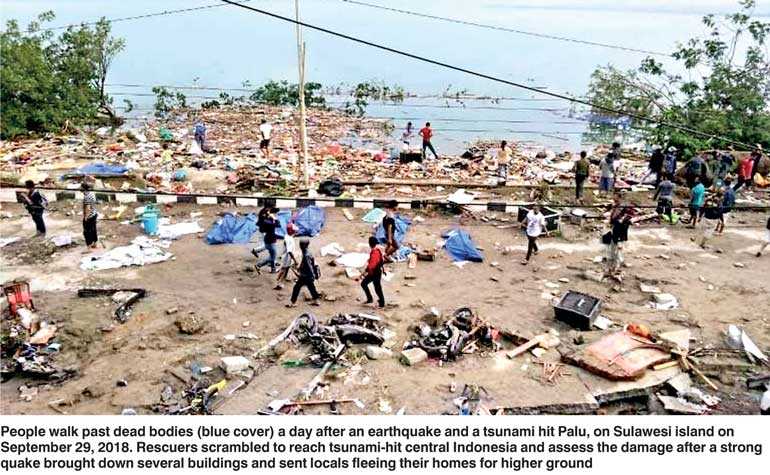Monday Mar 10, 2025
Monday Mar 10, 2025
Monday, 1 October 2018 00:50 - - {{hitsCtrl.values.hits}}

Palu, Indonesia (Reuters): The toll from an earthquake and tsunami in Indonesia soared on Sunday to 832 confirmed dead, with authorities fearing it will only climb as rescuers struggle to reach outlying communities cut off from communications and help.
Dozens of people were reported to be trapped in the rubble of two hotels and a mall in the city of Palu, which was hit by waves as high as six metres (20 feet) following the 7.5 magnitude earthquake on Friday.
A young woman was pulled alive from the rubble of the Roa Roa Hotel, the news website Detik.com reported. Hotel owner Ko Jefry told Metro TV on Saturday that up to 60 people were believed trapped. Hundreds of people gathered at the mall searching for loved ones.
With most of the confirmed deaths from Palu, authorities are bracing for much worse as reports filter in from outlying areas, in particular, Donggala, a region of 300,000 people north of Palu and closer to the epicentre of the quake, and two other districts.
Vice President Jusuf Kalla said the toll could rise into the thousands.
National disaster mitigation agency spokesman Sutopo Purwo Nugroho told a news conference the affected area was bigger than initially thought, though rescuers only had good access to one of four affected districts - Palu. “We haven’t received reports from the three other areas. Communication is still down, power is still out. We don’t know for sure what the impact is,” he said.
“There are many areas where the search and rescue teams haven’t been able to reach,” Nugroho said, adding that teams needed heavy equipment to move broken concrete.
Five foreigners - three French, one South Korean and one Malaysian - were among the missing, he said. The 832 fatalities included people crushed in collapsing buildings and swept to their death by tsunami waves.
Donggala town has been extensively damaged, with houses swept into the sea and bodies trapped in debris, according to a Metro TV reporter on the scene.
The Red Cross said it had heard nothing from the Donggala region.
“This is extremely worrying,” it said in a statement. “This is already a tragedy, but it could get much worse.”
National search and rescue agency Chief Muhammad Syaugi told Reuters rescuers were flying to Donggala by helicopter.
Finance Minister Sri Mulyani Indrawati said the government had allocated 560 billion rupiah ($37.58 million) for disaster recovery, media reported.
Questions about warnings
Indonesia is all too familiar with deadly earthquakes and tsunamis. In 2004, a quake off Sumatra Island triggered a tsunami across the Indian Ocean, killing 226,000 people in 13 countries, including more than 120,000 in Indonesia.
Questions are sure to be asked why warning systems set up around the country after that disaster appear to have failed on Friday.
The meteorological and geophysics agency BMKG issued a tsunami warning after the Friday quake but lifted it 34 minutes later, drawing criticism it had withdrawn it too quickly. But officials said they estimated the waves had hit while the warning was in force.
Hundreds of people had gathered for a festival on Palu’s beach when the water smashed onshore at dusk. A disaster official said the tsunami travelled across the sea at speeds of 800 kph (500 mph) before striking the shore.
Video footage on social media showed waves surging ashore in huge swirls of debris as people scattered.
Palu is at the head of a narrow bay, about 10 km long and 2 km wide, which had “amplified” the force of the wave as it was funnelled toward the city, a geophysics agency official said.
Questions have been raised about what caused the tsunami, with speculation an underwater landslide was to blame.
The BMKG said its closest sensor, about 200 km (125 miles) from Palu, had only recorded an “insignificant”, six-cm (2.5 inches) wave, while researchers said it was surprising the quake, which was recorded as a “strike-slip” event, when tectonic plates move horizontally against each other rather than vertically, had generated a tsunami.
“It may be that the shock of the quake triggered a landslide underwater,” Abdul Muhari, who heads a tsunami research team that advises the government, told Reuters.
About 16,000 displaced people were seeking shelter and needed clean water, Nugroho said, while 540 were people were injured, many getting treatment in tents set up in the open.
Discover Kapruka, the leading online shopping platform in Sri Lanka, where you can conveniently send Gifts and Flowers to your loved ones for any event including Valentine ’s Day. Explore a wide range of popular Shopping Categories on Kapruka, including Toys, Groceries, Electronics, Birthday Cakes, Fruits, Chocolates, Flower Bouquets, Clothing, Watches, Lingerie, Gift Sets and Jewellery. Also if you’re interested in selling with Kapruka, Partner Central by Kapruka is the best solution to start with. Moreover, through Kapruka Global Shop, you can also enjoy the convenience of purchasing products from renowned platforms like Amazon and eBay and have them delivered to Sri Lanka.
Discover Kapruka, the leading online shopping platform in Sri Lanka, where you can conveniently send Gifts and Flowers to your loved ones for any event including Valentine ’s Day. Explore a wide range of popular Shopping Categories on Kapruka, including Toys, Groceries, Electronics, Birthday Cakes, Fruits, Chocolates, Flower Bouquets, Clothing, Watches, Lingerie, Gift Sets and Jewellery. Also if you’re interested in selling with Kapruka, Partner Central by Kapruka is the best solution to start with. Moreover, through Kapruka Global Shop, you can also enjoy the convenience of purchasing products from renowned platforms like Amazon and eBay and have them delivered to Sri Lanka.